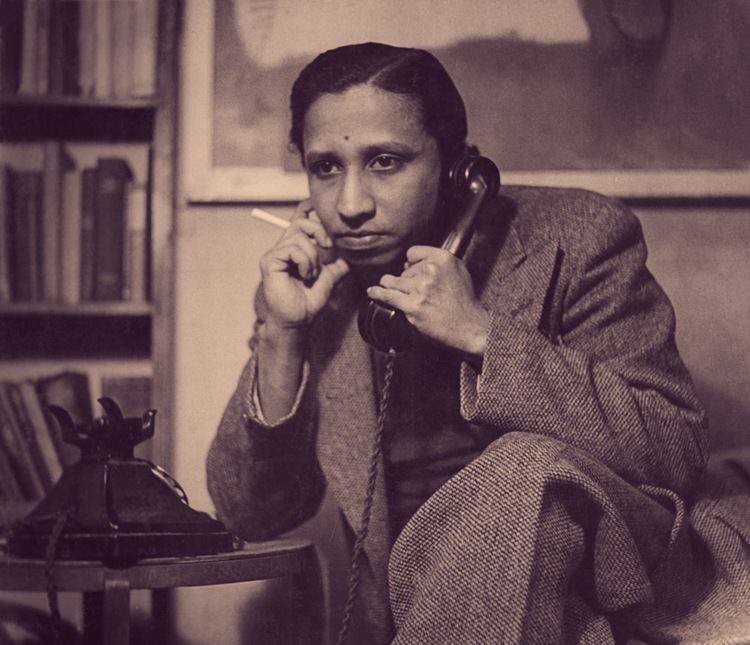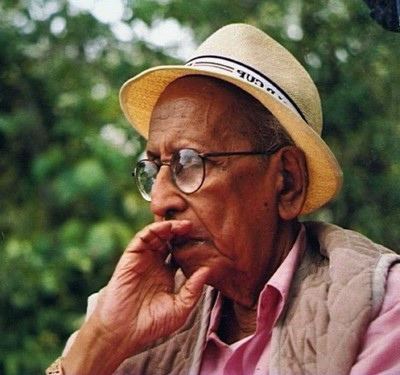Years active 1949–present Name Lester Peries | Role Film director | |
 | ||
Occupation Film director, Film producer and Screenwriter Website www.ljpspfoundation.org Parents Ann Gertrude Winifred Jayasuria, James Francis Peries Siblings Ivan Peries, Erica Peries, Noel Peries Movies Gamperaliya, The Treasure, Rekava, Golu Hadawatha, Baddegama Similar People | ||
Remembering Sri Lanka's greatest Film Director Lester James Peries
Sri Lankabhimanya Lester James Peries (Sinhala: ශ්රී ලංකාභිමාන්ය ලෙස්ටර් ජේම්ස් පීරිස්) (born 5 April 1919) is an internationally acclaimed Sri Lankan film director, screenwriter, and film producer. An active filmmaker since 1949, Peries has been involved in over 28 films, including shorts and documentaries. He has received critical acclaim for directing Rekava, Gamperaliya, Nidhanaya, Golu Hadawatha, Kaliyugaya, Awaragira and Yuganthaya. His movie Wekande Walauwa, starring Ravindra Randeniya and Malini Fonseka, was Sri Lanka's first ever submission for the Academy Awards. Peries' films often deal with Sri Lankan family life in rural settings and conflicted characters. He helped create an authentic expression of Sinhala Cinema.
Contents
- Remembering Sri Lankas greatest Film Director Lester James Peries
- Lester james peries aux archives du film de colombo 2006
- Early life
- Stay in England
- Back in Ceylon
- Personal life
- Career
- Short films
- Awards and recognition
- The Lester James Peries and Sumitra Peries Foundation
- The Lester James Peries Film Archive
- Literature and records
- References
Lester james peries aux archives du film de colombo 2006
Early life

Lester James Peries was born on 5 April 1919 in Dehiwela, Colombo, Ceylon. His father, Dr. James Francis Peries, studied medicine in Scotland and was also a cricketer for a Scottish club. His mother, Ann Gertrude Winifred Jayasuria, was a graduate of St. Bridget's Convent in Colombo. Peries had three siblings: Erica, Ivan and Noel.
The Peries family was a staunch Roman Catholic family that had become Anglicised. Growing up, Peries only spoke English at home and celebrated Christian traditions. His only link to Sinhala culture was his grandmother who always didn't trust Western medicine and spoke proper Sinhalese. At the age of eleven, Peries was given a 8mm Kodascope projector by his father as a gift, which ran Chaplin's silent movies. At that time, his only interest in films was when he and his brother Ivan would haunt the cinema to watch foreign film serials which ran day after day. Peries was never involved in school drama productions, and had no idea he was going to be a film director especially since British Ceylon did not have its own national film industry at that time.
He attended St. Peter's College- one of the leading Catholic schools in Colombo- as a teenager, before dropping out to pursue a career in journalism at the age of 17. He found his first work with the Daily News writing for the blue pages which was an arts supplementation. In 1939 he joined The Times of Ceylon working under Indian editor Frank Moraes. He also reviewed books on Radio Ceylon for a short period.
Peiris first real work with production came when he joined a theatre group called Drama Circle. This was a group of like minded individuals which regularly produced modern English plays. Here Peries was engaged in all aspects of the productions other than acting.
Stay in England
In 1947, Peries travelled to England on his mother's advice to join his brother Ivan Peries who was there on an art scholarship. Moreas suggested writing a column from the country to be published in the Times which became "Letter on the Arts from England."
During that time, film-making was taking off in the UK with about 400 amateur film clubs around the country. In addition, Peries' passion for the cinema was developing and he met another Sri Lankan with similar interests, Hereword Jansz. The two youngsters decided to make a film together despite Hereword having his doubts about competing with established, well-funded clubs. They began with Peries writing the script and directing while Hereword did the filming with their limited camera equipment. Their first effort 'Soliloquy' (1949), a short film, won the Mini Cinema Cup for displaying the best technical proficiency. This work was followed by three other experimental films.
In 1952, the editor John Hockin told Peries of an interesting assignment he had for him – an interview with the new head of the Government Film Unit of Ceylon. At the end of the interview, the head of film unit Mr Keene inquired after Peries' own interest in making films. He knew about Peries' talent because he sat on one of the juries that presented the upcoming director with an amateur's award. Keene suggested that Peries return to Ceylon to embark on a career on filmmaking.
Back in Ceylon
Upon the return to Ceylon of producer Ralph Keene in 1952, Peries joined the Government Film Unit as Keene's assistant. Two major documentaries he helped Keene with were Heritage of Lanka and Nelungama. He also directed Conquest in the Dry Zone, a documentary on controlling malaria and Be Safe or Be Sorry, a witty study on errant motorists. At this time, a relative of Peries' suggested he start a company to produce Sinhala films. Peries left Government Film Unit in 1955 and created Chitra Lanka Limited to produce two films. Only one, Rekava, was ultimately produced. Peries' closest colleagues at the Government Film Unit, William Blake, a cameraman of Dutch descent, and Titus de Silva (Titus Thotawatte), an editor, resigned with him and later worked together on a number of films.
Personal life
Peries met his wife, Sumitra, who is also a film director, in Paris at the home of a mutual friend and married in 1964 at All Saints Church in Borella. Peries' brother is artist Ivan Peries.
Career
In 1956, Peries made his entry into national cinema with the globally acclaimed "Rekava", which was a story based on village life. It was nominated for the Palme d'Or at the 1957 Cannes Film Festival. With this film he revolutionised Ceylonese cinema, giving it a unique identity. It was the first Ceylonese movie to be shot outdoors. Although it was acclaimed internationally it was not a commercial success. Afterward he made many award-winning films such as "Gamperaliya" in 1964 based on Martin Wickramasinghe's famous novel; "Delowak Athara" in 1966; "Golu Hadawatha" in 1968 based on the novel by Karunasena Jayalath; "Nidhanaya" in 1970; "Yuganthaya" in 1983 and many more. He has directed over 20 feature films.
Short films
Awards and recognition
The Lester James Peries and Sumitra Peries Foundation
The Lester James Peries and Sumitra Peries Foundation was inaugurated on 9 June 2011 at the BMICH with an oration by the chief Guest - celebrated Indian film maker Padma Vibushan Dr. Adoor Gopalakrishnan and the Speaker of Parliament Chamal Rajapakse was the Guest of Honour. The Foundation is incorporated through an act of Parliament of the Democratic Socialist Republic of Sri Lanka. The bill of incorporation was forwarded to parliament by Hon. Malini Fonseka on 5 January 2011. The foundation focuses on the following general objectives-
1. To provide assistance for the development, promotion and sustenance of the Sri Lankan cinema and to those associated with it;
2. To promote and foster cinema and related arts and crafts for children and young adults;
3. To promote, improve, develop, provide financial assistance and maintain academic, scientific, cultural, literary, artistic and physical abilities and aptitudes;
4. To promote, propagate and foster humanitarian ideals, democratic and pluralistic values, good citizenship, patriotic concepts and beliefs;
5. To improve, develop, create, foster and maintain talents and abilities in entrepreneurship, research and training in business, technology and management and concept of income generating and self-employment ventures and enterprises; to establish, improve, encourage, develop and maintain research and research facilities in scientific, cultural, educational, economic and all other aspects of human development;
6. To advise and assist the Government, NGOs and individuals in the furtherance of the objectives of the Foundation;
7. To preserve and promote all cinematographic and any other creations of Lester James Peries and Sumitra Peries made by them including scripts, manuscripts, books, letters, articles, poems, photographs, audio cassettes, VHS cassettes, CDs, VCDs, DVDs, MP3s and any other audio devices, visual devices and media;
8. To preserve all cinematic equipment and personal memorabilia owned and used by Lester James Peries and Sumitra Peries;
9. To maintain Archives to promote and preserve all cinematographic and any other creations of any Sri Lankan film maker;
10. To grant prizes, rewards, awards or scholarship to develop, promote and encourage creative talents in general or in particular fields;
11. To organize, conduct and participate in seminars, meetings, workshops, discussions, talks, classes, films, film shows, demonstrations, sports, and recreational activities, and to write, print and publish books, periodicals, magazines, articles and newspapers, in furtherance of the objectives herein specified and specifically in all areas of educational activity;
12. To establish and maintain libraries, workshops and readings rooms, and to equip the same having regard to the primary objects of the Foundation;
13. To publish articles, periodicals or such other literature and information as may prove necessary or useful for the purpose of the Foundation;
14. To undertake and execute any trusts the undertaking whereof seems desirable and either gratuitously or otherwise.
The Foundation operates from Peries' residence and is involved in organizing many events annually to promote the film industry of the past and present in Sri Lanka.
The Foundation is spearheaded by its trustees- Dr. Lester James Peries, Mrs. Sumitra Peries, Mr. Yadamini Gunawardene, Mr. Kumar de Silva and Mrs. Gayathri Mustachi. Also on the board of directors serves Ms. Yashodha Wimaladharma, Mr. Sameera Manabharana Randeniya, Mr. Yasoja Gunawardene and Mr. Nuran Gomez.
The "Lester James Peries Film Archive"
The most recent development on Dr. Lester James Peries is the building of a film archive in his name. From the time he was a young film maker one of his only requests was that the government make way for a proper film archive that would help protect the heritage of the films produced by Sri Lanka. On 5 April 2014, his own milestone 95th birthday, his request was granted when the National film corporation ceremoniously opened the "Lester James Peries Film Archives" at the request of His Excellency President Mahinda Rajapakse. The event was followed by a photographic exhibition of Dr. Peries' life and works.
Literature and records
Peries has written approximately twenty books. The most-well known of them are LJP Life and Works (Prof. A. J. Gunawardene), Lester by Lester (as told to Kumar de Silva) and Lester (Prof. Sunil Ariyaratne).
A music CD was produced by The Lester James Peries and Sumitra Peries Foundation containing 21 songs from Peries' films.
Some of Peries' films have been restored and placed in DVD format.
